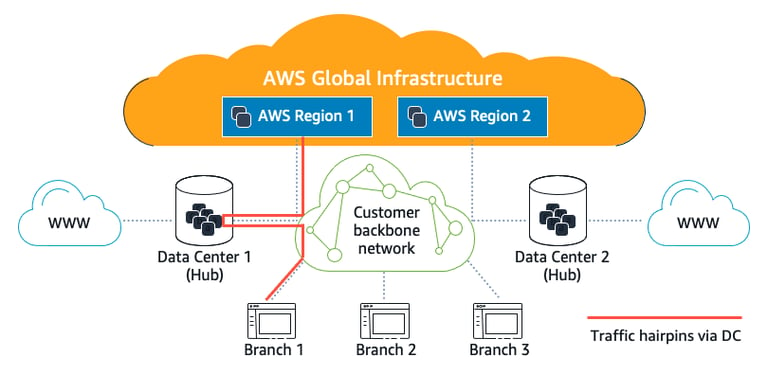AWS Networking: Building Robust and Secure Networks in the Cloud
Find out how AWS transforms business networking with tools like Amazon VPC, subnets, routing options, security groups, and Elastic Load Balancing. These features help improve scalability, security, and connectivity in your cloud setup.


Amazon Web Services (AWS) has revolutionized networking in businesses with its cloud services. AWS provides many networking tools that help organizations build strong and secure networks to meet their needs. Let’s look at how these key components of AWS networking make modern cloud systems more successful:
1. Amazon Virtual Private Cloud (VPC)
At the core of AWS networking lies Amazon Virtual Private Cloud (VPC). Using this service, users can designate logically separated areas of the AWS cloud in which to allocate their resources. VPC gives you complete control over your network setup. You can manage things like IP address ranges, subnets, route tables, and network gateways.
By creating a VPC, organizations can establish a secure and private network environment within the AWS cloud. This lets businesses easily link their on-site systems to the cloud, creating a hybrid cloud setup that fits their unique needs.
2. Subnets and Routing
Subnets are logical divisions of the IP address range associated with a virtual private cloud (VPC) that users can construct within the VPC. Subnets enable organizations to segment their network infrastructure and control traffic flow effectively.
Routing is key in AWS networking because it decides how data moves between different subnets, VPCs, and outside networks. AWS offers different routing options to help manage your network. These include route tables, Internet Gateways, NAT Gateways, and Virtual Private Gateways. These tools help organizations create detailed network designs and secure communication paths.
3. Security Groups and Network Access Control Lists (ACLs)
AWS networking provides strong security features to keep your networks and resources safe. These safeguards aid in preventing unwanted access and safeguarding your information. Two important tools you can use are Security Groups and Network Access Control Lists (ACLs). These help you set detailed security rules to control who can access your network and resources.
Security Groups work like virtual firewalls, managing the traffic coming in and going out of each instance. They let you set specific rules based on protocols, ports, and IP addresses. This helps ensure that only the traffic you approve is allowed through.
ACLs, or network access control lists, function at the subnet level and offer an extra degree of protection. ACLs let organizations set rules for incoming and outgoing traffic in a subnet. This gives extra control over how network traffic moves between subnets.
4. Elastic Load Balancing
In a cloud setup, Elastic Load Balancing is key to managing incoming traffic by spreading it across several instances. Three varieties of load balancers are offered by AWS:
Application Load Balancer (ALB) – Best for routing traffic based on content.
Network Load Balancer (NLB) – Ideal for handling high traffic and extreme performance needs.
Classic Load Balancer (CLB) – The older option that works well for simple use cases.
Each type has its strengths, so you can choose the one that fits your needs best.
The Application Load Balancer (ALB) is great for apps that need smart routing based on content, like handling HTTP and HTTPS traffic. The Network Load Balancer (NLB) is designed for high-performance tasks. It works best with TCP and UDP traffic, making it great for applications that need very low delays. CLB is the legacy load balancer that supports both HTTP and HTTPS traffic.
With Elastic Load Balancing, organizations can boost their application's reliability, scalability, and performance. Load balancers spread traffic evenly across working servers. This helps share the workload and prevents any one server from failing.
5. Virtual Private Network (VPN) and Direct Connect
AWS networking offers easy ways for organizations to connect their existing systems with the AWS cloud. It ensures a secure and smooth link between your on-premises setup and the cloud, making it simple to integrate and protect your data.
A Virtual Private Network (VPN) lets organizations safely connect their local networks to their VPCs over the Internet. This means they can extend their current network to the cloud and safely access resources in their VPCs.
Direct Connect gives you a dedicated link between your data center and AWS. Using this private connection keeps your data off the public internet. This means you get faster speeds, lower delays, and better security.
Conclusion
AWS networking offers many services to help organizations build strong and secure networks in the cloud. The fundamental component is Amazon Virtual Private Cloud (VPC), which gives you complete control and freedom when designing your network. You can use subnets, routing options, security groups, and load balancers to create a network that grows and performs well. AWS also provides connectivity options like VPN and Direct Connect to ensure your network meets your specific needs.
Organizations have two main goals when using AWS networking. They want to move their current infrastructure to the cloud or create new applications. AWS provides a number of resources and services to assist with both. These tools make sure that your network is secure and works efficiently.


